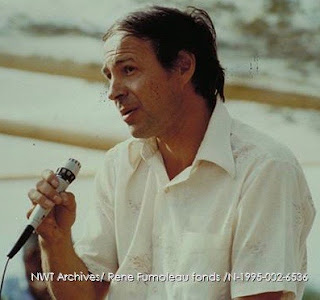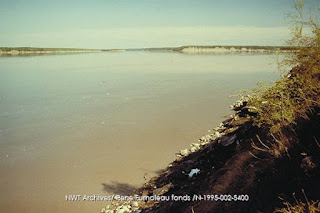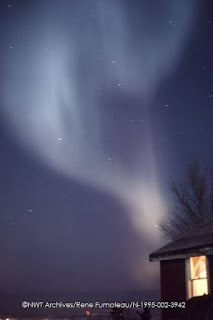Disclaimer: My references to the writings of other people–both Indigenous and Non-Indigenous–do not in any way imply that they share my views on this matter. The opinions expressed here are my own, and do not necessarily reflect those of my family, friends or associates.
Note One: The photos included with this post are by Rene Fumoleau (b. 1926), who has lived in the North for more than 50 years. He has donated more than 15,000 images to the NWT Archives: https://www.nwtarchives.ca. I can use the eight included here, with attribution, because this is my personal blog. But including them does not imply in any way that he shares my opinions.
If you want to look at more of Fumoleau’s creations, go to the Fumoleau section of the NWT Archives site.
Note Two: Around 2014, I instituted a policy regarding both my blogs that I do not include links to other people’s websites or blogs on mine. Consequently, you find information on how to locate the links (but not hyperlinks). Further clarification can usually also be found in the bibliography.
Introduction
I first became aware of Nick Sibbeston’s memoir, “You Will Wear a White Shirt” (2015), when I read about it in a 2015 Northern News Services column by honorary Dene chief Cece Hodgson-McCauley (1922-2018). The fact that Hodgson-McCauley made note of his memoir made me interested in reading it, because I frequently shared her honest and forthright opinions.
When she passed away in March 2018, Sibbeston was quoted in the press as saying she was “fearless, spirited, civic-minded [and]. . .just marvellous.” His praise provided yet another motivation.
I was also intrigued because Sibbeston was very much involved with Northwest Territories (NWT) politics both times I was in the capital city of Yellowknife. My first time, May 1975 to October 1976, I was employed by the Indian Brotherhood of the Northwest Territories (IBNWT) in the library/central files area. (The IBNWT became the Dene Nation in 1978.) During my second time, November 1983-April 1987, I was employed by the Dene-Metis Negotiations Secretariat on library/archives matters. Both times I trained Dene/Metis people.
For most of the 1970s to the early 1990s, Sibbeston was an elected member of the NWT’s Legislative Assembly. Although I do not believe I ever met him, I was very much aware of what he was up to because he frequently pushed for, or helped enact, major changes to territorial policy. During the time he was premier, 1985-1987, his trailblazing initiatives accelerated.
 |
| Nick Sibbeston at Fort Good Hope Dene National Assembly, July 1980 (cropped, edited) |
Preliminary Comments about “You Will Wear a White Shirt”
“You Will Wear a White Shirt” covers Sibbeston’s early life in his home community of Fort Simpson, Northwest Territories (NWT). He then discusses his negative, but occasionally positive, experiences at residential schools, not only in Simpson, but also in Fort Providence, Fort Smith, Inuvik and Yellowknife.
He then talks about his schooling at the University of Alberta (UofA), along with his marriage, family and work with the NWT government. We also learn about his business initiatives, his UofA law degree, and his work in the Senate. His memoir was published in 2015 when he was still a senator. In November 2017, on his 74th birthday, he resigned because he wanted to spend more time on other matters that were of interest to him.
For brevity’s sake, I will be concentrating on his political contributions, particularly during the time I was in Yellowknife. But what interests me the most is that he has returned to Fort Simpson, and, along with his wife Karen, is helping to re-establish the Sacred Heart Catholic Church. He believes the solution to the numerous historical conflicts between the Dene and the church, is to incorporate more Dene practices into the liturgy. Consequently, he is in the process of translating the Catholic Mass into one of the Dene languages, called Slavey.
Despite the fact that Sibbeston explores a lot of difficult topics in this book, I did not find it a chore to read; it was like he was having a conversation with me. And his honesty is refreshing; it is not an “it’s all the White man’s fault” Indigenous narrative. For instance, he freely acknowledges where he has benefitted from his interactions with Non-Aboriginals. But he also articulates how many aspects of colonization and the residential schools failed him and other Indigenous people.
He is not a proponent of the far-leftist, anti-development, absolutist rhetoric which I contend frequently stifles public discourse on what happens in the NWT. Consequently, he is not afraid to state an unpopular opinion, if that is his true conviction.
For instance, in 2005, he opposed the expansion of Nahanni National Park because “Aboriginal people. . .need money to run their governments and the mineral and fossil resources to create jobs for their people.” He distributed a “Nahanni Forever?” newsletter to every NWT household, which laid out his arguments. This newsletter provoked both applause and condemnation.
I agree with him that Aboriginal people need to be actively involved in business, both as individuals and through development corporations. He is right that “[t]raditional economies are insufficient to support growing populations and are often quite marginal. Only through wealth creation can sustainable communities be built.”
However, he also recognizes that development has to be responsible and not harm the environment. He is very concerned about how climate change in the NWT is contributing to “erratic weather and earlier open water.” He plans to be insistent that something be done about it.
Nunavut Senator Dennis Patterson, who succeeded Sibbeston as NWT premier, recommended Sibbeston’s book for its insights into the history of the NWT’s political development, and because it courageously told all. I have found the book helpful for those exact same reasons.
Sibbeston’s account of 1970s-1980s NWT happenings frequently transported me back to when I was living there. This process has helped me to more fully understand what was going on behind the scenes when major territorial policy decisions were being made. In addition, it has led me to conclude that I have three, albeit tenuous, connections to his life path.
 |
| Slave River, August 1982 |
My Three, Albeit Tenuous, Connections to Sibbeston’s Life Path
– In Fort Simpson During the Passing of the Dene Declaration, July 1975
The first is that, on July 19, 1975, I was in Fort Simpson at the Indian Brotherhood of the Northwest Territories Joint General Assembly, when the Dene Declaration was passed (I was a recording secretary, know shorthand). In his memoir, Sibbeston discusses the implications of this declaration. Although I agree with him there have been positive developments as a result of its passing, I think there has also been a downside. But I will leave that controversial topic for another day.
– At Yellowknife Airport When Pope John Paul II Spoke There, September 1984
Secondly, on September 18, 1984, I was at the Yellowknife airport when Pope John Paul II spoke to the crowd (including Dene and Metis leaders) gathered there. The Pope was supposed to be in Fort Simpson, but the plane he was in could not land because of fog. Nick’s wife, Karen, was instrumental in convincing the Pope to come to Simpson, not only during the failed attempt in 1984, but the successful one in September 1987.
I have a circa 1984 booklet which the Roman Catholic Church commissioned in preparation for the Pope’s visit. It covers Fort Simpson’s history from the 1800s to the 1980s. In addition, there are interviews with Dene and Metis elders about both their positive and negative experiences with the church. The booklet is entitled “Liidli Koe = Two Rivers of Faith (Fort Simpson, Denendeh)” Further information can be found in the bibliography. I will be discussing its contents in a bit more detail later in this post.
– My Parents, Jay Peterson (1920-1976) and Charles T. Peterson (1913-2007), Shared Nick and Karen’s Interest in Religious Matters
The third is that my mother Jay Peterson (1920-1976) shared Nick and Karen’s interest in religious matters. Mom was raised in a number of different Protestant religions, and said she benefitted from this diversity. She also believed in learning from other cultures. During the 1960s, she helped organize religious art exhibitions at First-St. Andrew’s United Church in London, Ontario. These exhibitions included not just Judeo-Christian, but also Muslim “Art and Artifacts.”
It is therefore not surprising that when I was growing up, Mom encouraged me to explore a variety of cultural and spiritual experiences beyond that of the United Church. I went to Catholic Mass, Jewish synagogue services, and Quaker “Friends’ meetings. In addition, I tagged along with her to Indigenous gatherings, such as the Indian Pageant at Six Nations of the Grand River.
To learn more about my mother, click on the “Jay Peterson” label in the right sidebar of my https://www.leithpeterson.ca blog.
My father, Charles T. Peterson (1913-2007), frequently said it was important to believe in a higher power than oneself. He was a long-time member of the United Church of Canada, right up until his final days. He also shared many of my mother’s interests, including regarding Indigenous issues. His funeral program included Biblical passages and an “Iroquois prayer.”
For further information about my father, click on the “Charles T. Peterson” label in the right sidebar of my https://www.leithpeterson.ca blog.
I have inherited my parents’ belief in reaching out to others across the cultural divide, so I applaud Sibbeston’s Dene-cizing the church initiative. I firmly believe the answer to much of the current racial strife often lies in hybridizing cultural systems instead of stressing their differences. For further information regarding my views on this, see my April 18, 2018 cultural misappropriation post, which can be found elsewhere on this blog.
My cultural misappropriation research, along with my personal experiences, and my reading of Sibbeston’s memoir, has made me acutely aware of many of the negative aspects of colonization. But there were some positive aspects, such as some Indigenous people gaining marketable skills that benefitted them later in life. Sibbeston noted many of the beneficial things he learned at some of the residential schools he attended.
It is also important to bear in mind that Indigenous cultures were not perfect before the White man came. One of the interesting aspects of the “Two Rivers” publication is that it covers Dene and Metis elders’ positive and negative experiences with, not only the church, but also with their own cultures.
My Narrative on Indigenous Issues Needs to be Considered in Context
In the “. . .Personal Journey” section of Part One of Three of my May 2016 https://www.counterpoise.ca series, I explained why I felt pressured to carry on my mother’s involvement in Aboriginal issues after she passed away in December 1976. The time period before, during and after her death was when Indigenous groups, including the Dene, were establishing a national presence, e.g., voicing opposition to the Mackenzie Valley Pipeline, due to unsettled land claims. Many of the people my mother had aligned herself with naturally hoped I would carry on where she left off.
But I had numerous concerns about this. One of them was that I am very much an integrationist by nature. I became more reticent as the “nation” concept increased in prominence. Although I did not express these views openly at the time, I inwardly felt more would be gained if Indigenous people developed marketable skills that would help them become part of the mainstream economy. However, I also realized that, at the same time, they needed to preserve, document and practise the positive aspects of their culture.
I knew my pro-mainstream views ran counter to what the “cause” was espousing. Consequently, I masked my true feelings, and carried on with a “crusader zeal” which only made matters worse in the long run. If you are interested in learning more about my inward/outward dilemma, read the “. . .Personal Journey” section.
Nevertheless, a beneficial aspect of my reluctant involvement was I wanted Indigenous people to run their own show. This was why I was insistent that I train Aboriginal people to take over the work I was doing. I did not want to be part of the process on a permanent basis. The advantage of it from an Indigenous perspective, particularly during Sibbeston’s time as an MLA and premier, was that I was busy training Dene and Metis people to take over. Since Sibbeston wanted more Indigenous people involved with decision-making, I am assuming he would have thought this was OK.
 |
| Fort Simpson – Dehcho-Liard River, 197-? |
Sibbeston’s Life Path: From Residential Schools to Senate to Simpson
I will first discuss Sibbeston’s early years, his time at various residential schools, his university degrees and marriage, and his career in territorial politics and the Senate. I will then talk about his healing journey, particularly during the 1985 to 2006 period. Finally, I will get to the part that I am most interested in, his Dene-cizing of the church in Fort Simpson.
“idyllic” Early Years, 1943-1949
From his birth in November 1943, until the early fall of 1949, Sibbeston was raised in Fort Simpson. His mother, Laura Sibbeston, had him out of wedlock, so he did not have a father. Although Laura is Metis, she was raised as a Dene by her adopted parents.
Sibbeston and his mother lived with a Dene woman named Ehmbee, who Nick considered to be his grandmother. Ehmbee could not speak Latin, French or English, but she faithfully brought Nick to Catholic Mass every Sunday. He considered these church experiences to be “. . .distant–like another world.”
Despite his misgivings about church services, he described his early years as “idyllic. . .[a] young boy could not have asked for a better upbringing.”
Residential Schools Attendance, 1949-1964
Sibbeston’s mother developed tuberculosis (TB) and had to go south to hospital. Consequently, in the fall of 1949, he was sent to the Fort Providence residential school. Although his mother returned from her hospital stay around 1955, she eventually moved to Hay River. She wanted to live in a place that had the southern amenities she had grown accustomed to during her illness.
From 1955 to 1964, Sibbeston attended residential schools in Fort Simpson, Inuvik and Yellowknife. The negative aspects of this schooling became more apparent to him during the 1980s–I will have more to say about this in the “Healing Journey” section below.
But there were some positive aspects to his education. He gained valuable academic skills, such as reading, writing and arithmetic. At Fort Smith’s Grandin College, he had some excellent teachers. In addition, he enjoyed playing hockey and basketball.
University of Alberta and Marriage
In the fall of 1964, Sibbeston started his studies at the Faculty of Education, University of Alberta. Some of his high school teachers had encouraged him to continue learning, so he thought perhaps he would emulate them and become a teacher.
He attended four classes with Karen Benoit, “a beautiful girl from Lloydminister, Alberta.” She did not drink and enjoyed liquor-free activities, particularly dancing.
Sibbeston got along well with Karen’s family. Her father was an “uprooted Acadian farmer,” and her mother was of British background. Karen was the fifth eldest of their 17 children.
During the fall and winter of 1967-1968, Nick and Karen worked as supervisors at Breynat Hall in Fort Smith. Sibbeston became friends with the Breynat administrator, Fr. Camille Piche. It was Piche who performed Nick and Karen’s marriage ceremony at a Lloydminster church on August 17, 1968.
I appreciated Sibbeston’s honesty about the “phenomenon” of Aboriginal and Non-Aboriginal people “getting together” frequently in the North. My experience has been that this topic is often taboo, even though it is so prevalent. He also said this intermingling “certainly stirs up the gene pool and creates a good breed of people.” You do not hear this observation very often from Indigenous people, even though I believe this hybridity is often beneficial.
in the summer of 1969, Glen, the first of Nick and Karen’s six children, was born. Nick received his Bachelor of Arts in April 1970, and became secretary-manager of the hamlet of Fort Simpson that fall.
 |
| Kakisa Lake, river, village, June 1978 |
Sibbeston’s Years in Territorial Politics, 1970-1975, 1979-1991
In December 1970, Sibbeston was elected MLA for Mackenzie-Liard. After he lost the 1975 election, he decided to pursue a law degree at the University of Alberta. He became the first Indigenous lawyer born and raised in the NWT. In 1979, he was re-elected and remained in territorial politics until 1991. From 1985 to 1987, he became the second Aboriginal NWT premier.
“You don’t get anything done by writing nice letters and speaking calmly”
In his book “Arctic Revolution” (1994), John David Hamilton (1919-2009) said Sibbeston was “. . . a very different kind of personality. . .who was constantly ruffling feathers.” I know exactly what Hamilton meant by this.
Sibbeston was determined to bring more recognition for Dene rights and culture in the assembly “both practically and symbolically.” He objected to the militaristic, Westminster style of government procedures, which paid almost no attention to “Northern culture.”
I burst out laughing when he said “. . .you don’t get anything done by writing nice letters, and speaking calmly. You have to slam the table and often raise your voice. . .”
Early 1980s Incidents That Don’t Fit into the “Speaking Calmly” Category.
I was not in Yellowknife when the following four early 1980s incidents occurred, but I certainly remember public debates and media reports about them.
– When the 1982 budget and subsequent assembly discussions on the matter of Dene languages failed to provide more funds for this purpose, Sibbeston spoke in Slavey. The proceedings “ground to a halt,” and “[e]veryone looked bewildered, moving uneasily in their seats.” This led to the Speaker recessing the house for a caucus meeting. At this meeting, Sibbeston got his wish to have an interpreter when he spoke in his language.
– During the 1982 winter session, in reply to the commissioner’s speech, he removed his suit and tie, and put on a fur-trimmed moose-hide jacket, adorned with beadwork. He encouraged his Dene and Metis colleagues to do the same in future, rather than be shackled to the government’s “suits and oxfords” rules.
– February 17, 1982: Sibbeston devoted about five pages of his memoir to before, during and after his hitting Inuk MLA, Tagak Curley, on the side of the head with his fist. For this, he was suspended from the house for the rest of the day. He apologized the next. There are complicated reasons for why this dustup occurred. I recommend reading the book to get more insight. Sibbeston said in his office he had a “framed editorial cartoon” of himself, fiercely making a point in the assembly, with a hockey-helmet-wearing Curley looking on.
– A few weeks after his “round with Tagak,” he caused a stir in the assembly again by throwing a coffee cup in the direction of the chair, Peter Fraser. The cup broke into pieces and the room fell silent. Before he headed out to the lobby, Sibbeston said he was resigning. Commissioner John Parker told him to go home and talk with his constituents. When he returned to Simpson, he was treated like a hero and told he should throw more cups.
Later in life, Sibbeston concluded that his “political passion to see right was done” for Indigenous people was definitely connected to the trauma of his residential schools years.
But outside of the “assembly ropes,” he could be “the picture of cooperation and collaboration.” By 1986, he had garnered mostly positive reviews for his work as minister and government leader.
1983-1987 – “Great Progress and Achievement” in the NWT
As Sibbeston states in his memoir “. . .1983 to 1987 was one of great progress and achievement in the Northwest Territories.” I can attest to the truthfulness of this because I was an eye witness to it.
Among the NWT milestones when Sibbeston was premier (1985-1987) were:
– Aboriginal employment in the territorial government increased from 17 to 26 per cent. This included appointing “strong Aboriginal people into senior positions.”
– Implementation of the Official Languages Act, 1984. English and French had full official status, along with official recognition of the seven Aboriginal languages.
– The NWT Pavilion at Expo 86 in Vancouver, British Columbia was one of the most popular Expo attractions. Inuk MLA, Tagak Curley, among others, helped to make the pavilion a success. It brought in more than a million dollars during its sixth-month operation.
– National political and constitutional meetings included the NWT’s involvement.
Of course, all these major changes were bound to rub some people the wrong way. Sibbeston acknowledged that “MLAs and the media did not always agree with my decisions or actions.”
I remember the shock in Yellowknife when Sibbeston terminated a number of Non-Aboriginal bureaucrats, and replaced them with Indigenous people. His actions were a huge departure from the federal government’s longstanding assimilationist policy.
 |
| Blueberry, n.d. |
Dene and Metis Divisions
I share Sibbeston’s disappointment with the breakdown of the Dene and Metis land claims process. For about three years after I left Yellowknife, I had some NWT publications mailed to me, because I wanted to follow what was going on. I was not surprised when the Dene-Metis Negotiations Secretariat shut down in November 1990.
I agree with Sibbeston that one of the factors contributing to the breakdown was the 1984 Inuvialuit Final Agreement. The Inuvialuit (Western Arctic Inuit) obtained both extensive surface and limited subsurface rights to renewable resources in their region. As Sibbeston points out, this settlement has contributed substantially to improving the social and economic well-being of its inhabitants.
The Dene regions near the Inuvialuit, and the Southern Metis, could see the benefits of settling. But the southern Dene wanted to hold out for a better deal. Unfortunately, this deferral has led to a far more complex negotiations process. Although some claims are settled, there are still regional, and even community-level claims, in process.
I do understand why Indigenous communities would want to hold out for a better deal, but I fret about the impact the decades-long process is having on the NWT’s economy. Since July 2015, I have had a subscription to Northern News Services, which covers happenings in the NWT. It makes me very sad to see how many problems there are, not only in Yellowknife, but also in many of the communities. Unemployment, addiction and crime are at record levels. I realize there are complex reasons for this, that are not entirely related to land claims or the economy. But I suspect if the remaining claims are settled, it would lead to more certainty, not only for Northern residents, but also for potential investors.
Sibbeston believes the breakdown in the Dene and Metis claims process has had some negative impacts in the Western Arctic. He said “[t]he complexity of the regulatory system is due, at least in part, to the patchwork implementation of land claims.”
But he also realizes that economic development in the NWT must not be of the “boom and bust” variety. In 2012, he helped draft a report which set out a “vision for development that is both progressive and sustainable.”
 |
| Lutsei K’e – backlit silhouette – Dandelion, 197-? |
Sibbeston”s Healing Journey, circa 1985 to 2006
Throughout his “young adult life,” Sibbeston drank, partied and chased women. This behaviour continued for a long time after his marriage.
When he was in territorial politics, particularly when he was government leader, he also suffered from post-traumatic stress disorder (PTSD) and mild depression. As his self-destructive and mental health issues took an increasing toll on his personal and family life, he realized he had to get help.
Through “counsellling and self-reflection” he concluded that the six years he spent at the Fort Providence residential school, without seeing his mother, were the “most traumatic” period of his life. He was teased because he was fairer than the other boys, he was sexually assaulted by an older Aboriginal boy, and he was “treated cruelly by the nuns.”
His wife Karen’s “love and forgiveness,” and his “faith in God” were what saved him. Despite his negative experiences with the church, he has been able to move past his resentment. He now advocates that the church incorporate Dene cultural practices into the liturgy. I will have more to say about this “Dene-cizing” in the section below about his work at the Fort Simpson church.
Sibbeston regained his well-being by quitting drinking in 1985 and by attending Marriage Encounter sessions with Karen. In 2006, he was inspired by Margaret Trudeau’s account of her struggles with mental illness, and got further help from an Ottawa psychiatrist.
Christianity and Indigenous Spirituality Finding Common Ground in Quite a Few Indigenous Communities in Canada
Although you would not know it by reading many mainstream media accounts, Christianity and Indigenous Spirituality are finding common ground in quite a few places in this country. Statistics Canada’s 2011 National Household Survey found that two out of three Aboriginal Canadians consider themselves Christian, although their church attendance was not necessarily on a regular basis.
Since about 2006, I have maintained a file of articles on this Christian/Indigenous Spirituality hybridity. Rather than cite all these items, I suggest interested readers do an online search for “Christian” and “Indigenous” or “Aboriginal.” Canadian journalist, Douglas Todd, has written about this topic a number of times, so you could do an online search of his name, along with the other keywords.
Consequently, Sibbeston’s work combining the Indigenous with the Christian at the Sacred Heart Church in Fort Simpson is part of a trend to be found elsewhere.
 |
| Fort Simpson – Sun. – Trees, March 8, 1986 |
Sibbeston’s London, Ontario Veritas Lecture, September 22, 2016
On September 22, 2016, Sibbeston gave a presentation entitled “Incorporating Indigenous Spirituality into Church Liturgy and Practice.” His contribution, which was sponsored by the Sisters of St. Joseph, was part of the Veritas Series for Faith and Culture. This hour-plus event took place at King’s University College in London, Ontario.
I am sorry I missed this lecture in my hometown, but fortunately a video of the proceedings is available for viewing online. For further information, see the bibliography.
Sibbeston referred to his early years sitting on his grandmother Ehmbee’s knee at the church. He said almost all of the services were in Latin or French. Ehmbee would “lighten up” when the priest occasionally spoke in Dene.
In more recent years, the services have been conducted in English, but he thought a greater number of Dene people would attend if their culture was more part of the service. It has been a challenge for him to translate the liturgy into Slavey because many of the concepts are not based on matters the Dene are familiar with. But he believes it is worth the effort, so that what is actually going on is understood.
Re-Establishment of the Sacred Heart Church in Fort Simpson
As Sibbeston explained during the London, Ontario lecture, the Fort Simpson community came together to make sure the church was re-established. The original church, which was built in 1923, had to close in October 2009 because it was structurally unsound.
When the Diocese of Mackenzie-Fort Smith Bishop, Mark Hagemoen, visited Fort Simpson in 2013, he concluded that now was the time to rebuild. At that point, local parishioners had raised $300,000 towards the church, through bake sales, bottle drives, and other fund-raising initiatives.
Hagemoen managed to secure the remaining funding and support from the Archdioceses of Edmonton and Hamilton, as well as Catholic Missions in Canada.
On September 17, 2017, the new $1.3 million Sacred Heart Church opened. Some of the items in the new structure had been saved from the old, including the baptismal font, made of local diamond willow.
When the consecration Mass was over, a special service was held at the site of Pope John Paul II’s September 20, 1987 visit.
Days before the church opening, Hagemoen had been appointed the new Bishop of Saskatoon, so he greeted the consecration of the new parish with mixed emotions.
During the opening, Sibbeston was quoted as saying “if we could Dene-cize the Church, we could use our language and we could have songs in our language, people will come back.”
On Sundays, he, along with other parishioners, translates the Mass into Dene. Drumming is often part of the service. The offerings are collected in a birch-bark basket and a moose-hide blanket.
 |
| Ndilo – Rene’s house – Northern Lights, March 1971 |
Conclusion
As mentioned in the “Healing Journey” section above, Sibbeston said he was saved by “Karen’s love and forgiveness” and his ‘faith in God.” His faith came from his grandmother Ehmbee, who attended church every Sunday, and who “lived a life of kindness, gentleness and love.”
I think Karen deserves extensive praise for her patience and understanding during her husband’s trials and tribulations. And I strongly suspect Ehmbee is beaming down from heaven at the good work her grandson is doing.
Bibliography
Catholic Missions in Canada. (2016, October 14). Sacred Heart Church in Fort Simpton, Northwest Territories. Retrieved from Catholic Missions in Canada: https://cmic.info/missions-in-focus/sacred-heart-chrch-in-fort-simpson.
CBC News. (2017, September 21). N.W.T. Senator Nick Sibbeston resigns. Retrieved from CBC News: https://www.cbc.ca/news/
Cooke, L, & Piche, C. (1984?). Liidli Koe = Two Rivers of Faith (Fort Simpson, Denendeh). Yellowknife? Native Communications Society of the Western NWT.
DeGroot, P. (1984, September 19). Yellowknife residents delighted by papal visit. Edmonton Journal.
Dene Nation. (2019, May 29). Dene Nation – History. Retrieved from Dene Nation: https:denenation.com/about/history
Edwards, T. (2108, March 17). ‘I did very well, didn’t I?’ Retrieved from Northern News Services: https://www.nnsl.com
Ehrkamp, A. (2017, September 17). Fort Simpson rejoices as new church opens. Retrieved from Grandin Media: https://grandinmedia.ca
Ehrkamp, A. (2017, December 13). New church in the North a symbol of reconciliation Retrieved from Grandin Media: https://grandinmedia.ca
Hamilton, J.D. (1994). Arctic Revolution: Social Change in the Northwest Territories, 1935-1994. Toronto: Dundurn.
Hodgson-McCauley, C. (2015, December 21). Make Daryl Dolynny NWT ombudsman! Retrieved from Northern News Services: https://www.nnsl.com
News/North. (1990, November 19). Negotiations office to shut down November 30.
Northern News Services (2017, September 24). New church, renewed hope. Retrieved from Northern News Services: https://nnsl.com
NWT Archives. (2019, May 23). Copies and Use of Archival Material. Retrieved from NWT Archives: https:www.nwtarchives.ca
O’leary, K.P. (2015, March 4. Expo 86. Retrieved from Canadian Encylopedia: thecanadianencyclopedia.ca
Prince of Wales Northern Heritage Centre. (2019, May 30). Seasons of Beauty: Photographs by Rene Fumoleau. Retrieved from Prince of Wales Northern Heritage Centre: https://www.pwnhc.ca
Senate of Canada. (2016, March 31). Meet Senator Dennis Patterson. Retrieved from Senate of Canada: https://sencanada.ca
Sibbeston, N. (2015). You Will Wear a White Shirt. Madiera Park, BC, Douglas & McIntyre.
Sibbeston, N. (2016, September 22). Incorporating Indigenous Spirituality into Church Liturgy and Practice. Retrieved from King’s University College: https:www.kings.uwo/ca/campus-ministry
Statistics Canada (n.d.) 2011 National Household Survey: Religion. Retrieved May 2019 from Statistics Canada: https://www12.statcan.bc.ca
Wikipedia. (2019, March 12). Nick Sibbeston. Retrieved from Wikipedia: https://en.wikpedia.org/wiki/Nick_Sibbeston
